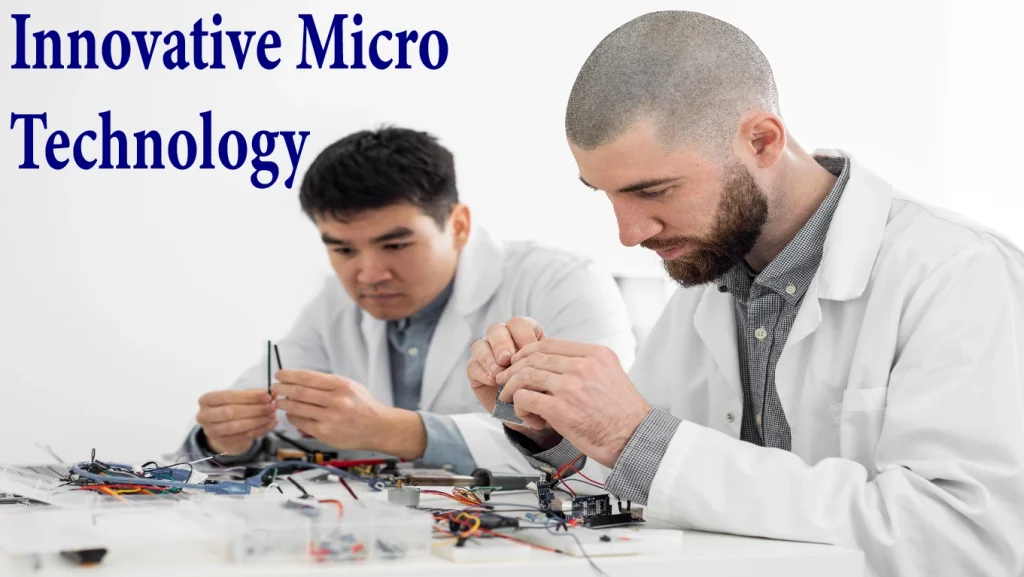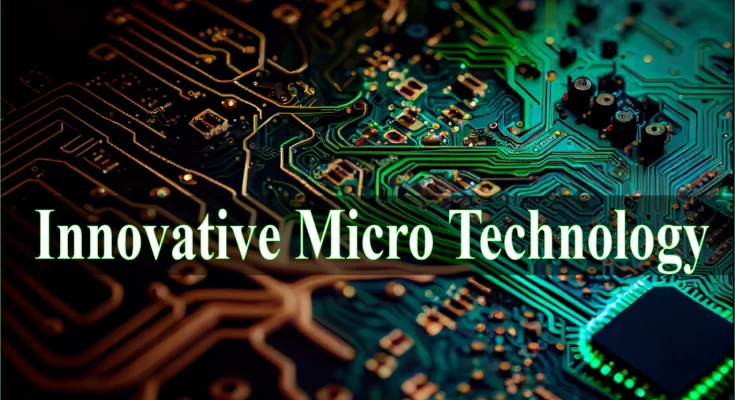Welcome to the future, where science fiction is becoming reality! Innovative Micro Technology has emerged as a game-changer, revolutionizing industries and pushing the boundaries of what we thought was possible. From tiny sensors that monitor our health in real-time to miniature robots performing intricate surgeries, this blog post will take you on an exhilarating journey through the incredible world of Innovative Micro Technology. Join us as we unveil how these marvels are reshaping industries and paving the way for a future filled with endless possibilities. Buckle up, because things are about to get small but mighty!
Introduction to Innovative Micro Technology
Innovative Micro Technology technology is a rapidly advancing field that deals with the development and use of extremely small devices, components, and systems. It involves the manipulation and control of materials at the micro and nano scale, which are measured in micrometers (millionth of a meter) or nanometers (billionth of a meter). This technology has been gaining momentum in recent years due to its vast potential for revolutionizing various industries.
The concept of Innovative Innovative Micro Technology was first proposed in 1959 by physicist Richard Feynman in his famous lecture “There’s Plenty of Room at the Bottom”. He envisioned a world where machines could be created on an incredibly small scale, leading to advancements that were previously unimaginable. Over time, this vision has become a reality with the advent of powerful tools such as electron microscopy and other advanced manufacturing techniques.
One of the key features that distinguishes Innovative Micro Technology from conventional technology is its size. These tiny devices are so small that they cannot be seen with the naked eye. They require specialized equipment such as scanning electron microscopes or atomic force microscopes to be observed and manipulated. This means that engineers working in this field need to have a deep understanding of physics, chemistry, material science, and engineering principles.
How Innovative Micro Technology is Changing the World
Innovative Micro Technology, also known as nanotechnology, is the manipulation of matter on a molecular or atomic scale. It involves designing and creating structures and devices at a microscopic level, with dimensions ranging from 1 to 100 nanometers. While this may sound like something out of a sci-fi movie, micro technology is already making a significant impact in various industries and changing the world as we know it.
One of the most notable ways that Innovative Micro Technology is revolutionizing industries is through its advancements in medicine and healthcare. With the use of tiny sensors, medical professionals are now able to monitor patients’ vital signs in real-time and make more accurate diagnoses. Micro robots are also being developed for targeted drug delivery, enabling precise treatment at the cellular level without harming healthy cells. Additionally, miniaturized medical devices such as pacemakers and insulin pumps are becoming more common, improving patient comfort and reducing the risk of infection.
In the field of electronics, Innovative Micro Technology has played a crucial role in creating smaller and more powerful devices. The miniaturization of electronic components has led to the development of smartphones, tablets, laptops, and other portable gadgets that have become an essential part of our daily lives. Not only do these devices provide convenience and accessibility but they also consume less energy due to their smaller size.

Healthcare Industry
The healthcare industry has been greatly impacted by the advancements in Innovative Micro Technology. From cutting-edge medical devices to efficient data management systems, micro technology is revolutionizing the way healthcare is delivered and managed.
Innovative Micro Technology is also making surgeries less invasive and more precise with the use of robotic surgical tools. These state-of-the-art instruments have improved precision and dexterity, allowing surgeons to perform complex procedures with minimal incisions. As a result, patients experience reduced pain and scarring, shorter recovery times, and better overall outcomes.
Agriculture Industry
The agriculture industry has always played a crucial role in providing food and resources for the world’s population. However, with the increasing global population and changing climate conditions, traditional farming methods are facing challenges in meeting the growing demand for food. This is where Innovative Micro Technology comes into play.
Innovative Micro Technology refers to the use of small-scale devices or systems that operate at a microscopic level. In the field of agriculture, micro technology has enabled farmers to become more efficient, precise, and sustainable in their practices. From automated machinery to smart sensors, micro technology is revolutionizing every aspect of the agriculture industry.
Manufacturing Industry
The manufacturing industry has always been at the forefront of technological advancements, constantly striving to improve efficiency and productivity. However, with the emergence of micro technology, this industry is experiencing a revolutionary transformation.
Innovative Micro Technology refers to the use of microscopic components in various industrial processes. These components are typically smaller than 1 millimeter and can range from miniaturized sensors to tiny robotic devices. The application of micro technology in manufacturing has resulted in significant benefits such as increased precision, reduced costs, and improved product quality.
Transportation Industry
The transportation industry has been a crucial part of our daily lives, providing us with the means to travel from one place to another quickly and efficiently. However, like many other industries, it is not immune to the continuous advancements in technology. With the rise of micro technology, we are witnessing a revolution within the transportation industry that is set to transform how we move people and goods.
One of the most significant ways Innovative Micro Technology is revolutionizing the transportation industry is through autonomous vehicles. These self-driving cars use advanced sensors, artificial intelligence, and machine learning algorithms to navigate roads and make informed decisions without human intervention. This technology has already been tested on public roads by companies like Google’s Waymo and Tesla, showcasing its potential for widespread adoption in the near future.
READ MORE ARTICLE: SKYTECH SOLUTION
Benefits of Micro Technology
Micro technology, also known as microelectronics, is the field of technology that deals with the design and manufacture of extremely small electronic components. These tiny devices have revolutionized industries in ways that were previously unimaginable. From healthcare to transportation, Innovative Micro Technology has brought about numerous benefits and advancements that have greatly improved our daily lives.
One of the major benefits of Innovative Micro Technology is its ability to make devices smaller and more compact. This has allowed for the development of portable and wearable gadgets such as smartphones, fitness trackers, and smartwatches. These devices are not only convenient but also provide us with a wealth of information at our fingertips. With micro technology, we can access everything from communication to entertainment on a single device that fits in the palm of our hand.
In addition to portability, micro technology has also made devices more efficient and energy-efficient. The miniaturization of electronic components means less power is needed to run them, resulting in longer battery life for our devices. This has also led to the development of eco-friendly products that consume less energy and reduce our carbon footprint.
Challenges and Limitations of Micro Technology
While the advancements in micro technology have brought about numerous benefits and opportunities, it also comes with its own set of challenges and limitations. In this section, we will explore some of the common obstacles faced by micro technology and how they can potentially hinder its growth.
1. Size limitation
One of the major limitations of micro technology is its size constraint. As the name suggests, micro technology involves working with extremely small components and devices. This poses a challenge for engineers as they need to design and manufacture these tiny products without compromising their functionality or durability. Furthermore, the smaller size also makes it difficult to integrate certain features into these devices, limiting their capabilities.
2. Power consumption
Another challenge that comes with miniaturization is power consumption. With smaller devices, there is limited space for batteries or power sources which can lead to shorter battery life or reduced performance. This becomes a critical issue in industries such as medical or aerospace where reliability and longevity are crucial factors.
3. Cost
The production cost of micro technology is significantly higher compared to traditional manufacturing methods due to the precision required in designing and fabrication processes. This makes it challenging for companies to mass produce these products at affordable prices, ultimately hindering its widespread adoption.
4. Reliability
Micro technology relies heavily on intricate electronic components which are susceptible to failure due to various factors such as temperature changes, vibrations, electromagnetic interference etc. Ensuring reliability under extreme conditions becomes a major challenge for engineers working on micro technology applications in industries like aerospace or defense.
5.Human error
As much as we rely on automation and robots in producing delicate micro devices, human intervention is still necessary in many stages of development and assembly process which increases the chances of errors occurring during production.
Despite these challenges and limitations, researchers continue to push boundaries in developing innovative solutions that address these issues associated with Innovative Micro Technology.
While there are certainly roadblocks to overcome, the potential of Innovative Micro Technology in revolutionizing industries is undeniable. As we continue to push the boundaries of what’s possible with miniaturization, it is crucial that we address these challenges and limitations in order to fully harness the power and potential of this game-changing technology.
The Impact of Micro Technology in Healthcare
One major area where Innovative Micro Technology has had a significant impact is in medical imaging. With the development of smaller and more powerful sensors, doctors are now able to capture high-resolution images of internal organs and tissues, allowing for more accurate diagnoses. For example, endoscopic cameras can now be as small as 1mm in diameter, providing a less invasive alternative to traditional procedures such as colonoscopies.
There is no doubt that Innovative Micro Technology has brought about tremendous improvements in various aspects of healthcare. From diagnosis to treatment, the possibilities seem endless and will continue to evolve as technology advances. With its potential to save lives and improve quality of life, micro technology is undoubtedly one of the most exciting developments in the healthcare industry today.
MUST READ INTRESTING ARTICLE : Celebrating National Radiologic Technology Week| With 8 Headings




